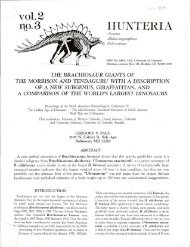THE MANY MYTHS, SOME OLD, SOME NEW, OF ... - Gregory S. Paul
THE MANY MYTHS, SOME OLD, SOME NEW, OF ... - Gregory S. Paul
THE MANY MYTHS, SOME OLD, SOME NEW, OF ... - Gregory S. Paul
You also want an ePaper? Increase the reach of your titles
YUMPU automatically turns print PDFs into web optimized ePapers that Google loves.
74<br />
G. S. PAUL<br />
(Coombs, 1978a; Halstead and Halstead, 1981; Ostrom, 1987; Padian, 1989; and<br />
Thulborn, 1989, who asserts that shire horses are the biggest gallopers).<br />
Reality: This is a very extensive, complex subject. Here it will be pointed out that a<br />
number of extinct tetrapods of two to 20 plus tonnes have limbs that are more gracile,<br />
more powerfully muscled, and less derived than the highly modified, slow action legs<br />
of elephants. These include large theropods, iguanodonts-hadrosaurs, ceratopsids,<br />
ankylosaurids, titanotheres, giant extinct rhinos, and the indricotheres. In particular,<br />
all of these retain highly mobile ankles and long feet that allow a push off into a<br />
long suspended phase. This suggests that these animals were much faster than<br />
elephants, being capable of a true run with an airborne phase. In the modern fauna,<br />
rhinos are the biggest high speed gallopers.<br />
A number of biomechanic and scaling studies support the possibility that speed can<br />
remain high in large animals if they retain the proper body design, and if they<br />
properly scale limb and body proportions as size increases (Heglund et al., 1982;<br />
McMahon, 1984; Lindstedt et al., 1985; Alexander, 1989). The retention of legs that<br />
are both virtually identical in morphology and increasingly strong and powerful in<br />
ornithomimids and tyrannosaurs of increasing size is one of the best examples of this<br />
phenomenon (<strong>Paul</strong>, 1988a). In addition, adults are usually as fast or faster than their<br />
young, even when their limbs are stouter and distally shorter, so tyrannosaurs should<br />
not have lost speed as they grew up from their gracile young. Bald assertions that big<br />
animals cannot be fast are therefore obsolete (Figure 3).<br />
Figure 3 The elephantine bulk of 6 tonne Triceratops horridus was not a barrier to galloping because,<br />
unlike elephants, it had the strong boned, powerfully muscled, and flexed jointed limbs needed to propel it<br />
at high speeds.









